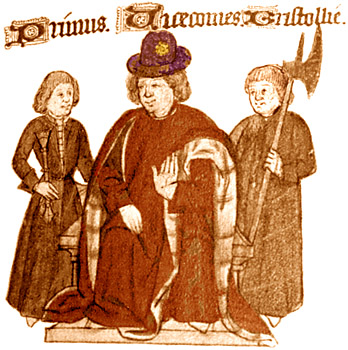
The first sheriff of Bristol
original in Bristol Record Office, MS. 04720 f.100
The original full-colour colour depiction of the first sheriff of Bristol, elected pursuant to the city charter of 1373 (see "Petition requesting county status be granted by charter"), illustrated the volume known as Ricart's Kalendar. It was placed within a listing of the city's principal officers.
The newly-elected sheriff, John Vyell, is shown centre, seated on the dais in the guildhall. He is apparently acknowledging his audience. He wears as livery a scarlet gown trimmed with white fur, and a blue domed hat bearing a golden badge (possibly a rose), probably a symbol of shrieval office. In Ricart's time (1480s) the city paid an allowance of £6.13s.4d for 10 yards of cloth for the sheriff's livery, and £5 for the fur; there were relatively extravagant sums, given the overall size of the city budget.
The two men flanking him carrying the axe and mace, more potent symbols of office, might perhaps be intended to represent (left) mayor William Canynges and (right) one of the bailiffs; but more probably, based on the colour of their liveries, they are the sheriff's sergeants. The depiction reflects more accurately a sheriff's livery at the time when Ricart was town clerk than at the time when Vyell was sheriff.
John Vyell was a member of a Bristol branch of a county family; the surname would appear to be a patronymic. Another member of the family, merchant-draper Henry Vyell (likely John's father), had served as a town councillor in the years following the first visitation of the Black Death, and as bailiff of Bristol in 1359/60. He, or another of the name, also held a ballivalty in 1371 and shrievalty in 1376. John Vyell himself was a city bailiff for two consecutive terms from 1369 to 1371.
Despite obtaining from the king in 1374, only months after completing his shrieval term, a life exemption from the offices of mayor and sheriff, along with royal offices, and in 1382 a confirmation of that exemption, he accepted election to the post of constable of the Bristol staple in 1378, continuing therein for four years, and (having served on the city council in the 1380s) election as Bristol's mayor in 1388. In the years preceding his mayoralty he had even shouldered the unpopular duty of tax collector on several occasions. He was thus a man prepared to do his duty, but careful to ensure that he had some say in what would be the extent of that duty.
His service as an officer of the staple was the type of obligation many of the mercantile class were prepared to undertake. He was much involved in the export of cloth, sending his wares to France, Spain, Portugal and Ireland, and also invested in its manufacture – he was described as a draper, but this is indicative more of commercial than craft activity. His trade dealings are also reflected through his membership in socio-religious gilds in Coventry and Lynn. Through marriage, and with the money he made from commerce, he built up property holdings in Bristol, including shops and a stone house near the quayside, which was his residence. He also came into possession of a manor in Somerset.
John Vyell died in 1399, survived by his widow Elizabeth and sons Henry and John. The beneficiaries of his charitable bequests included city almshouses, the poor residents of St. Bartholomew's hospital, poor people who were bedridden; £20 was bequeathed to pay off small debts of selected debtors in a city prison, so that they could be set free. He instructed that anyone claiming a debt from him, who swore to the truth of it on the Bible, was to be paid. To St. Stephen's church he left a ring bearing what he believed to be a relic: a stone chip from a pillar to which Jesus had been bound. He ordered that expenses on his funeral be limited, but paid for 1,000 masses to be said for his soul, after death.